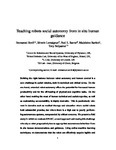Teaching robots social autonomy from in situ human guidance
| dc.contributor.author | Senft, E | en |
| dc.contributor.author | Lemaignan, S | en |
| dc.contributor.author | Baxter, PE | en |
| dc.contributor.author | Bartlett, M | en |
| dc.contributor.author | Belpaeme, T | en |
| dc.date.accessioned | 2019-11-08T15:13:53Z | |
| dc.date.available | 2019-11-08T15:13:53Z | |
| dc.date.issued | 2019-10-23 | en |
| dc.identifier.other | eaat1186 | en |
| dc.identifier.uri | http://hdl.handle.net/10026.1/15128 | |
| dc.description.abstract |
<jats:p>Striking the right balance between robot autonomy and human control is a core challenge in social robotics, in both technical and ethical terms. On the one hand, extended robot autonomy offers the potential for increased human productivity and for the off-loading of physical and cognitive tasks. On the other hand, making the most of human technical and social expertise, as well as maintaining accountability, is highly desirable. This is particularly relevant in domains such as medical therapy and education, where social robots hold substantial promise, but where there is a high cost to poorly performing autonomous systems, compounded by ethical concerns. We present a field study in which we evaluate SPARC (supervised progressively autonomous robot competencies), an innovative approach addressing this challenge whereby a robot progressively learns appropriate autonomous behavior from in situ human demonstrations and guidance. Using online machine learning techniques, we demonstrate that the robot could effectively acquire legible and congruent social policies in a high-dimensional child-tutoring situation needing only a limited number of demonstrations while preserving human supervision whenever desirable. By exploiting human expertise, our technique enables rapid learning of autonomous social and domain-specific policies in complex and nondeterministic environments. Last, we underline the generic properties of SPARC and discuss how this paradigm is relevant to a broad range of difficult human-robot interaction scenarios.</jats:p> | en |
| dc.format.extent | 0 - 0 | en |
| dc.language | en | en |
| dc.language.iso | en | en |
| dc.publisher | American Association for the Advancement of Science (AAAS) | en |
| dc.title | Teaching robots social autonomy from in situ human guidance | en |
| dc.type | Journal Article | |
| plymouth.issue | 35 | en |
| plymouth.volume | 4 | en |
| plymouth.journal | Science Robotics | en |
| dc.identifier.doi | 10.1126/scirobotics.aat1186 | en |
| plymouth.organisational-group | /Plymouth | |
| plymouth.organisational-group | /Plymouth/Faculty of Science and Engineering | |
| plymouth.organisational-group | /Plymouth/REF 2021 Researchers by UoA | |
| plymouth.organisational-group | /Plymouth/REF 2021 Researchers by UoA/UoA11 Computer Science and Informatics | |
| plymouth.organisational-group | /Plymouth/Research Groups | |
| plymouth.organisational-group | /Plymouth/Research Groups/Marine Institute | |
| plymouth.organisational-group | /Plymouth/Users by role | |
| dcterms.dateAccepted | 2019-09-16 | en |
| dc.rights.embargodate | 2019-11-15 | en |
| dc.identifier.eissn | 2470-9476 | en |
| dc.rights.embargoperiod | Not known | en |
| rioxxterms.versionofrecord | 10.1126/scirobotics.aat1186 | en |
| rioxxterms.licenseref.uri | http://www.rioxx.net/licenses/all-rights-reserved | en |
| rioxxterms.licenseref.startdate | 2019-10-23 | en |
| rioxxterms.type | Journal Article/Review | en |


